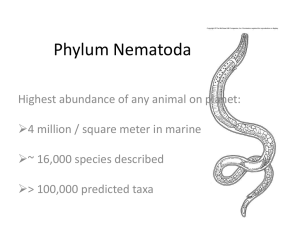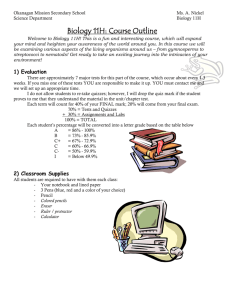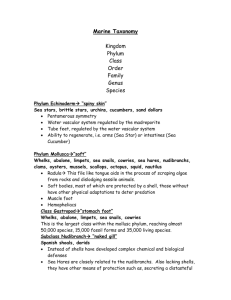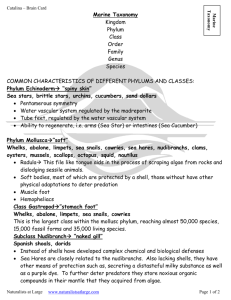Phylum Nematoda
advertisement
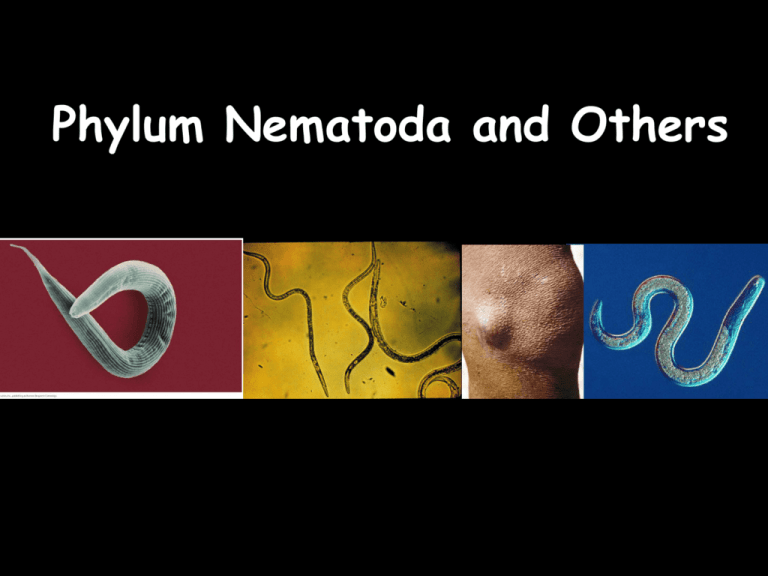
Phylum Nematoda and Others Goals for today • Learn to recognized the Phylum Nematoda and 2 other smaller phyla from other animals • Learn the main ‘diagnostic’ characteristics • Learn about some free-living and parasitic species biology Phylum Nematoda: roundworms Nematod are the most diverse phylum of pseudocoelomates, and one of the most diverse of all animals Key characteristics of the phylum: •Body elongated and round body. •Unsegmented •Cuticle •Nervous system with pharyngeal nerve ring •Has no circulatory system •Unlike cnidarians or flatworms, roundworms have a digestive system that is like a tube with openings at both ends. •Pseudocoelomate •Widespread and abundant in all habitats; some parasitic Phylum Nematoda: Your Tasks Exercise 9A: – Phylum: Nematoda • Genus: Ascaris lumbricoides, A. suum Ascaris lumbricoides is a common intestinal parasite of humans. A. suum paralyzes pigs. Nearly ¼ of the human population is infected with this roundworm. The eggs are resistant to chemicals, remaining viable in 2% formalin, and 50% solutions of the common laboratory acids So be careful!! Use gloves and wash your hands after the dissection Phylum Nematoda: Ascaris 1. Take a slide from your box with a cross section of a male and female Ascaris. Phylum Nematoda: Ascaris 2. Dissection. Use gloves at all times! Select one sex and then search for a student with the dissection of the opposite sex. Either can be in the exam! Female Male Ascaris lumbricoides cont. Female gut oviduct genital pore uterus vagina Ascaris lumbricoides cont. Male sperm duct seminal vesicle testes gut Male spicules Phylum Nematoda: Your Tasks Exercise 9A: – Phylum: Nematoda • Genus: Ancylostoma caninum (dog hookworm) Observe a slide of the dog hookworm. This is a common parasite of domestic dogs and cats. Try to note the cutting plates which uses to attach itself to the intestinal mucosa of its host. Read page 161 on hookworms Phylum Nematoda: Your Tasks Exercise 9A: – Phylum: Nematoda • Genus: Trichinells spiralis (trichina worm) Observe a slide of the trichina worm a parasite of humans, hogs, rats and other mammals Your slide is a cyst of the parasite Read page 162 on trichina worms Phylum Nematoda: Your Tasks Exercise 9A: – Phylum: Nematoda • Genus: Enterobius vermicularis (pinworms) Observe a slide of a pinworm which parasites humans in USA. They live in the large intestine and cecum. Read page 162-163 on pinworms Phylum Rotifera: Your Tasks Exercise 9A: – Phylum: Rotifera Observe a slide of a rotifer: Rotifers have a corona of cilia that is use for swimming and feeding. The foot has a pedal gland that secrets a cement to cling on substrate. The mastax is fitted with jaws for grinding food particles. The body is cover by a cuticle which in many roftifers is rigid and called lorica. They are pseudocoelomates They live in freshwater, moist soil, mosses, lichens, fungi, and even saltwater Phylum Acanthocephala: Your Tasks Exercise 9A: – Phylum: Acanthocephala Observe a slide of a spiny-headed worm. This worm is a parasite of pigs, where it attaches to the intestinal lining and absorbs digested food from its host. Like tapeworms it has not digestive system at all. probóscide invaginable erizada de espinas They are pseudocoelomates Important Links Nematods and others http://www.savalli.us/BIO385/Diversity/13.Nematoda.html http://en.wikipedia.org/wiki/Nematode http://en.wikipedia.org/wiki/Rotifer http://en.wikipedia.org/wiki/Acanthocephala http://faculty.evansville.edu/de3/b10802/PPoint/Pseudocoelomates/sld0 01.htm



